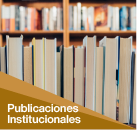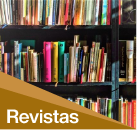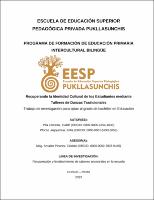Recuperando la Identidad Cultural de los Estudiantes mediante Talleres de Danzas Tradicionales
Fecha
2023-12-07Autor
Pila Zerceda, Yudith
Pfocco Jaqquehua, Zofia
Nivel de Acceso
Acceso AbiertoMetadatos
Mostrar el registro completo del ítemResumen
Esta investigación surge mediante la motivación personal, ya que desde niña observamos diversas danzas tradicionales que bailaban nuestros abuelos, tíos y personas mayores de la comunidad. Asimismo, por la alienación cultural tanto para danzar, cantar como usar formas de vestir, se percibe que estas prácticas culturales o danzas en un determinado contexto están desapareciendo. La documentación analizada e investigada sobre la danza en el ser humano es una forma de expresar vivencias y en especial para manifestar sentimientos sobre las labores agrícolas; así como, la convivencia entre las personas que vivimos en armonía apoyándonos unos a otros. Es por eso que nosotros nos proponemos recuperar la identidad cultural, realizando entrevistas y recopilando información de los sabios y danzantes mayores de la comunidad. Ahora, ya ancianos, los que han sido danzantes de jóvenes y de los cuales ya quedan pocos, nos ofrecen sus testimonios recuperados de otros abuelos. De esta manera, las danzas tradicionales pueden ser transmitidas a niñas y niños que pueden continuar estas prácticas culturales y, así, recuperar la identidad cultural de nuestro pueblo, cultivando la Educación Intercultural Bilingüe que se da en nuestra comunidad, con la propuesta de un proyecto educativo mediante talleres de danzas tradicionales como Sach`a huaylia y unu taq'iy e involucrar a los sabios o danzantes de la comunidad, que son yachaq de la comunidad. Abstract This research work has been conducted in the community of Antapallpa in the educational institution number 50366 Miguel Grau of Antapallpa in the district of Omacha in the province of Paruro Cusco region where we address the issue Recovery of cultural identity through a pedagogical proposal on traditional dances workshops in the community of Antapallpa, This research arises through a personal motivation that since childhood I observed various traditional dances where my grandparents danced my uncles and older people in the community, But today all these traditional dances are disappearing for reasons of religion, we also have the aspect of cultural alienation in dance I sing forms of dress in my community, this point is what motivates me to perform and recover these traditional dances so that today's children have the identity of our culture of the community of Antapallpa, especially in the dance Sach`a huaylia and unu taq'iy. The dance in the human being is a way to express our customs our experiences and especially in my community to express feelings agricultural work coexistence between people who live in harmony supporting each other, That is why we propose to recover this cultural identity that is being lost by conducting interviews and collecting information from the wise and older dancers of the community now elderly who have been dancers of young people and of which there are few left who give us testimony about these traditional dances to recover the cultural identity of our people that at the time these wise men transmitted their knowledge to young people to continue with these dances, From all this research work we obtain the result of recovering the cultural identity in our children of fifth grade of the educational institution Miguel Grau of Antapallpa with the proposal of an educational project recovering the cultural identity through workshops of traditional dances sach`a huaylia and unu taq'iy, which is known, appropriated and executed by the children of the educational institution where the wise men and women or dancers of the community, who are older people, are involved. Keywords: current dances, Andean dances, cultural identity. Pisirimayllapi Willasayki Kay yachay maskay llanq’ayqa ruwakamuran Antapallpa ayllu llaktapi yachay wasi yupaypi 50366 Miguel Grau de Antapallpa distritupi Omacha Paruro provinciapi, Cusco suyupi maypimi kay llakita rikunchik Identidad culturalta kutichipuy, huk propuesta pedagógica nisqawan, Antapallpa ayllumanta tradicional tusuy talleres nisqamanta kay investigacionqa paqarin huk motivación personal nisqawanmi, warma kasqaymantapacham qawarqani imaymana tradicional tusuykunata maypim abueloy, tioy hinaspa llaqtamanta kuraq runakuna tusurqaku, ichaqa kunan punchawkunapiqa tukuy kay tradicional tusuykunam chinkapushanña huy religionkunan haykupushan, Antapallpa aylluyman, identidad culturalta kutichipunaykupaq. chayqa chinkachkanmi entrevistakunata ruwaspayku hinaspa llaqtapa kuraqninkunamanta hinaspa tusuqninkunamanta willakuykunata huñuspa kunanqa kuraqña kachkanku, paykunam uchuyllaraq kachkaspanku tusuqku karqan, chaymantam pisillaña puchunku, paykunam testimonio nisqata willariwanku kay tradicional tusuykunamanta, llaqtanchikpa identidad culturalninta kutichipunanchikpaq chay pacha kay yachaysapa runakuna yachayninkuta wayna sipaskunaman apachirqanku chay hinapi kay tusuykunawan puririnankupaq, wawankuta yachaysapa yachachiq kanankupaq, chay hinapin tarpunku iskay simipi intercultural educación nisqa llaqtanchispi rikhurimuqta, tukuy kay maskhay llank’aymanta nuqayku Miguel Grau de Antapallpa yachay wasimanta pichqa ñiqipi qari warmanchikkunapi identidad culturalta kutichipuypa rurunta Sach`a Huaylia, Unu Taq`ey proyecto educativo nisqa propuestawan, identidad culturalta kutichipunanpaq, tradicional tusuy tallerkunawan chay yachay wasimanta qari warmakuna, warmi warmakuna chaypin yachaqkunawan kuska llank`arinqaku. Chanin rimaykuna: kunan pacha tusuykuna, andino tusuykuna, identidad cultural.







